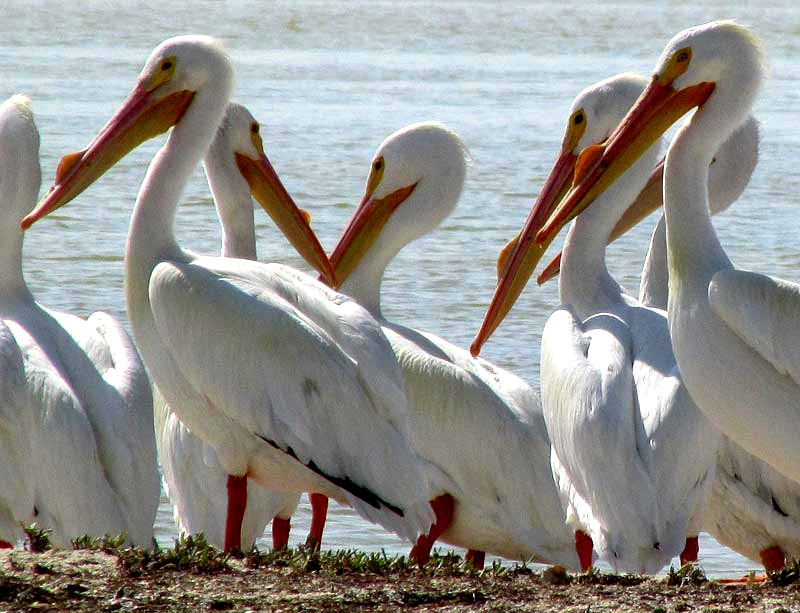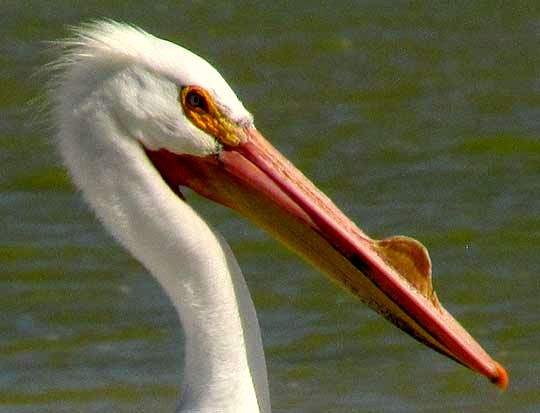Excerpts from Jim Conrad's
Naturalist Newsletter

from the the March 22, 2015 Newsletter issued from Río Lagartos, on the north-central coast of Yucatán, MÉXICO
WHITE PELICANS WITH "FINS"ON THEIR BEAKS
During a flamingo trip we dropped by a mudbar barely rising above the estuary's surface most of the time populated by hundreds of terns, gulls, Black Skimmers, pelicans and a variety of little long-legged waders, mostly sandpipers and plovers. This week the White Pelicans surprised us by bearing orangish, fin-like growths atop their beaks. Some birds had them while others didn't. They're shown above.
A closer look is provided below:

I'd heard of this phenomenon but never had a good look at it. It's described as a fibrous plate and sometimes is called a nuptial tubercle. Males develop them during the breeding season, but they fall off once the season is over. They're thought to contribute to the mating display. Before disappearing from the beak the tubercles may split vertically, forming irregular groupings of adhering fibers. In places up north where White Pelicans are found toward the end of the breeding season, birds with fraying tubercles sometimes called rough-bills. Such tubercle are peculiar to White Pelicans; our Brown Pelicans don't have them.
Down here, along with the recent outburst of daily singing of Tropical Mockingbirds and Northern Cardinals, these nuptial tubercles are yet another sign of spring rambunctiously dawning, and heading north.
from the January 4, 2015 Newsletter issued from Río Lagartos, on the north-central coast of Yucatán, MÉXICO

WHITE PELICANS
Nowadays it's common to see thirty or more White Pelicans quietly loafing on mud bars hardly rising above the surrounding salty water. Often all the birds have their bills pointed in the same direction, as shown above.
The other day I saw a flock of maybe 20 White Pelicans all clustered together in a tiny spot in open, shallow water stabbing into the water, with each stab coming up with what appeared to be a good catch. White Pelicans don't dive for food from the air or the water's surface like Brown Pelicans, so this floating and stabbing technique was normal for them. And I figure that the birds deserved their easy banquet and even their long hours of daylight loafing, because life isn't always easy for a White Pelican.
They deserve such breaks if only because they've recently made a long, dangerous flight from southern Canada or the north-central US, plus they began their lives with anything but peace and tranquility. Their parents had laid just two eggs, and afterwards the two chicks were programmed to compete with one another in the nest for survival. Typically the younger nestling dies from harassment. Siblicide is in their genes.
What a thing to see such peaceful pelicans on a mud bar all agreeing to point their bills in one way, despite their tough pasts.
from the the July 13, 2008 Newsletter, written in central Mississippi:
WHITE PELICANS LEFT BEHIND

Just north of Jackson in central Mississippi for eight miles the Natchez Trace runs along Ross Barnett Reservoir's western shore. Last Tuesday morning, after spending the night at a free campground on the Trace, we pulled up next to the fairly large lake's banks and were surprised to see four White Pelicans not far offshore. You can see three of them above.
Surprised, because White Pelicans overwinter in our area but breed much farther north and west, mostly in the US's upper western states and Canada's southern western provinces. The binoculars revealed the probably reason why White Pelicans would be so far south during their breeding season: One bird had a broken wing and the others' wings were malformed in various ways.
A pelican not appearing in the picture bore something conspicuous like a fleshy shark fin atop his massive, yellow-orange beak. At first I thought it must be yet another deformity, but then I read that breeding adult White Pelicans bear vertical plates rising from their bills, the plate playing a role in both courtship display and ritualized combat.
from the March 24, 2007 Newsletter, issued from Sierra Gorda Biosphere Reserve, QUERÉTARO, MÉXICO:
MIGRATING WHITE PELICANS
Tuesday morning about 50 White Pelicans appeared above Reserve HQ circling low and majestically the way White Pelicans do. They presented enough of a show for several of the workers to point and call to their friends. I guess the flock had spent the night at the reservoir next to us. Last fall I saw individuals and small flocks here, but since then they've been missing. My snapshot of Tuesday's flock in tight formation as they circled, gradually gaining altitude above our Sweet Acacias is shown below:

Most White Pelicans spend their summers in western Canada and a few spots in the northwestern US. They overwinter in the southern US and throughout most of Mexico into northern Central America.
It's hard to believe that spring migration is already here, but this flock was surely migrating. On the Internet I see that during spring migration White Pelicans pass through Oklahoma as early as March 11th, so this flock on March 20th had every reason to be migrating. Certainly after this little flock had circle and circled, each rotation a little higher than the last, they all drifted off in the right direction -- exactly toward the north.
It felt good seeing those big birds (wingspread 9.2 feet (2.8 m) heading north on the last day of winter, behaving exactly as they should. I hope they are graciously received up there and find healthy habitats awaiting them.